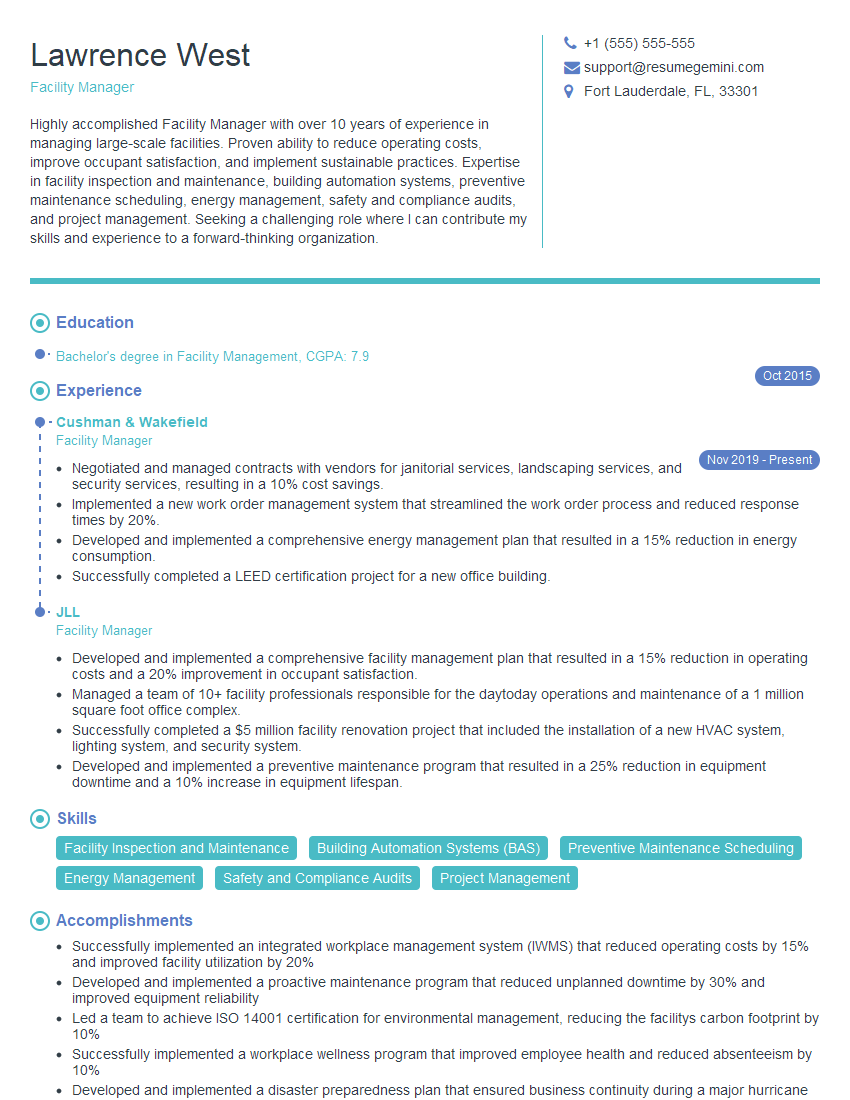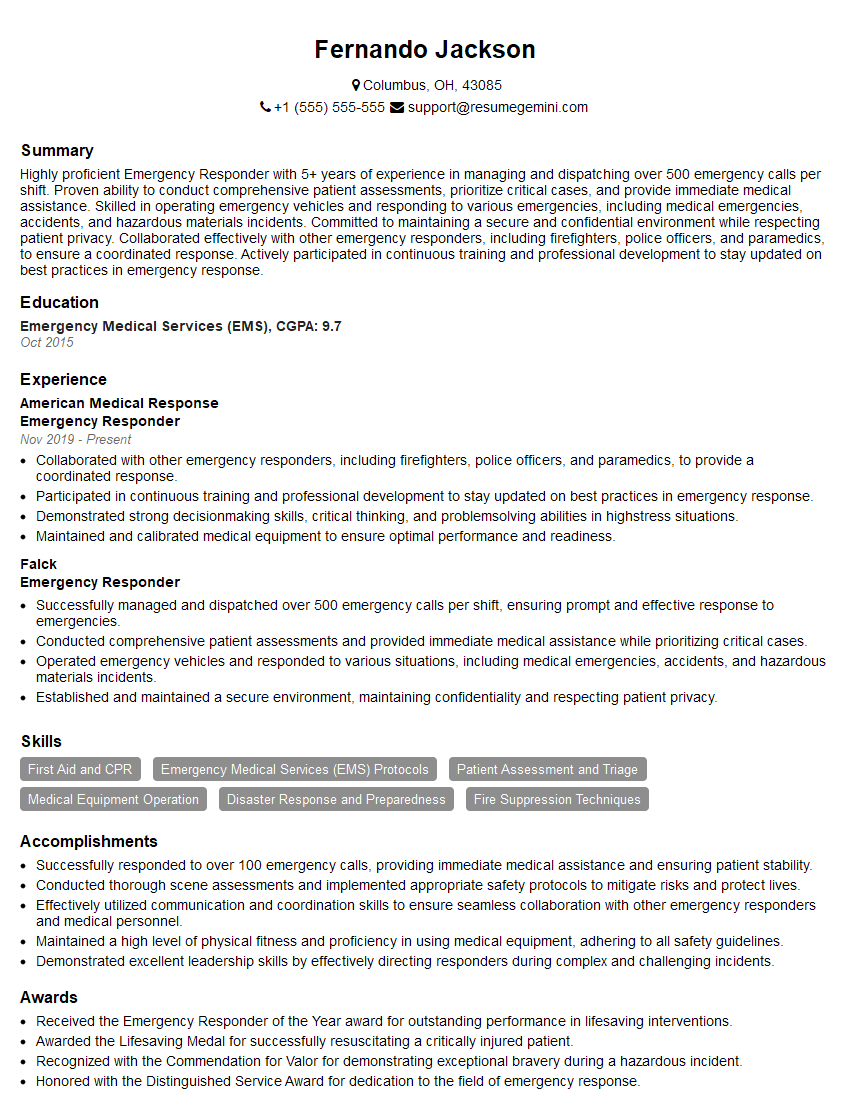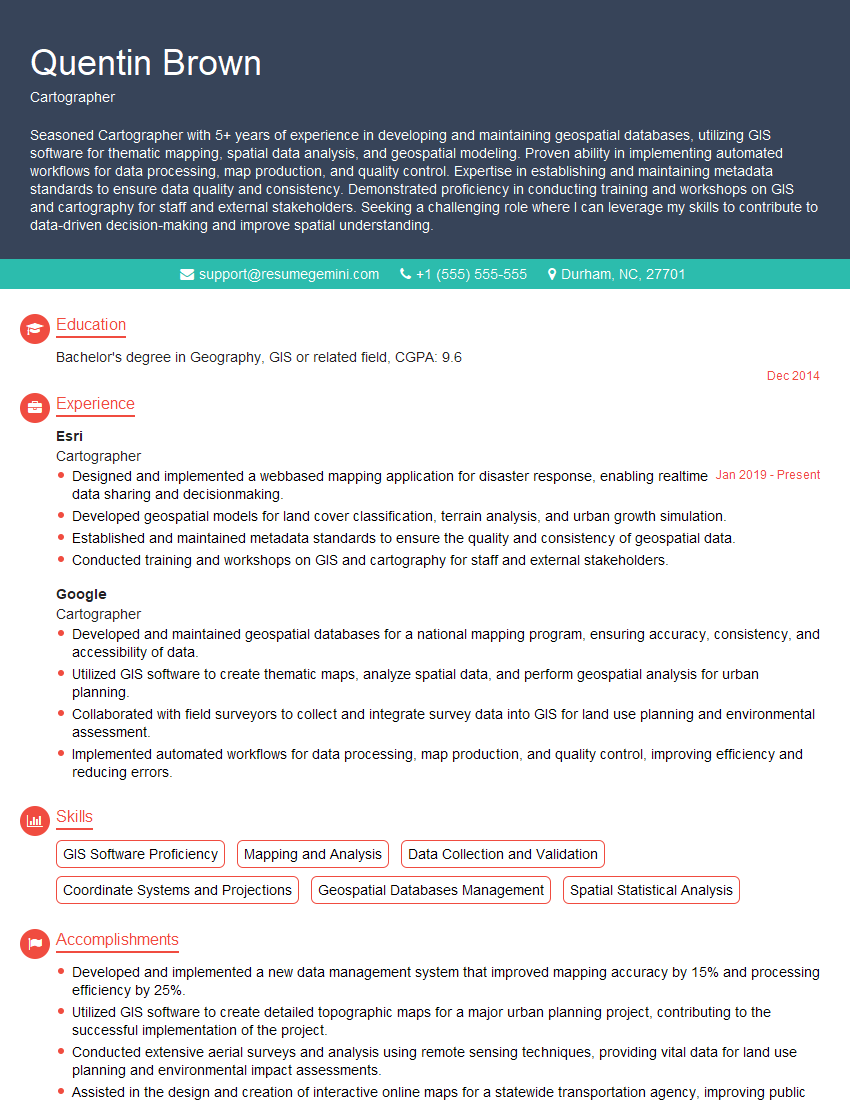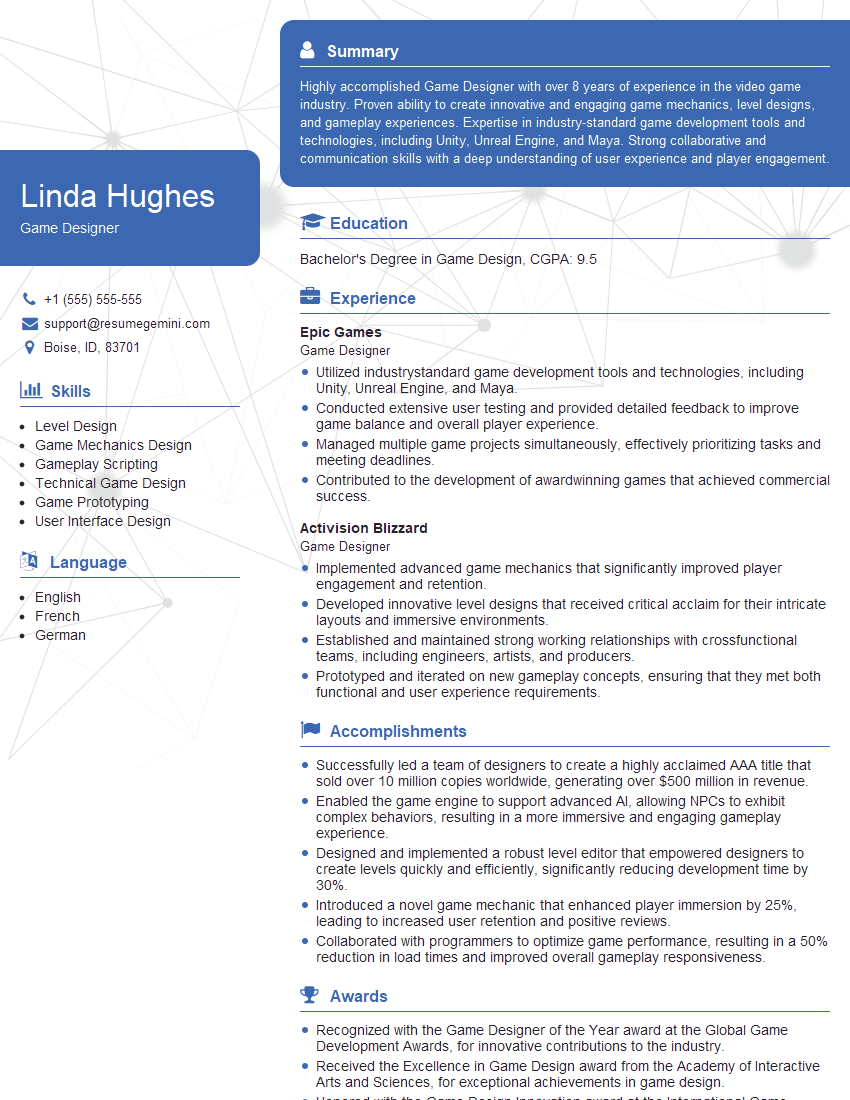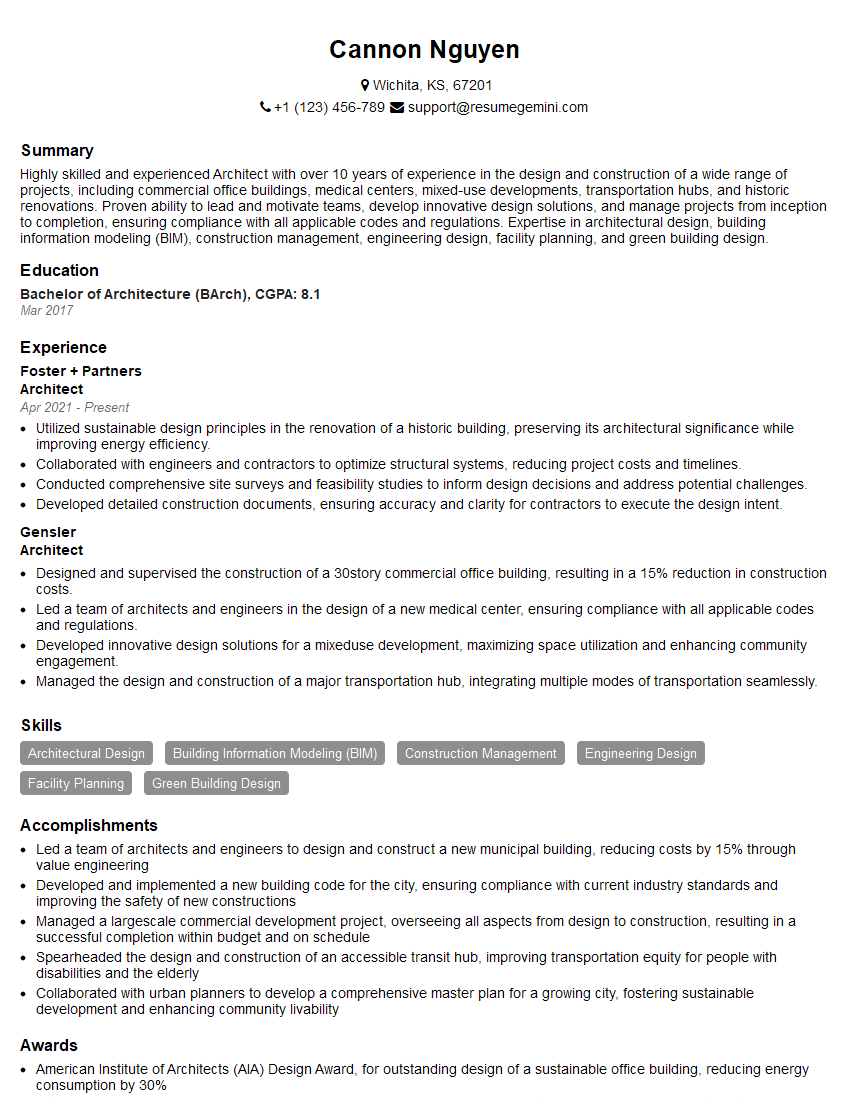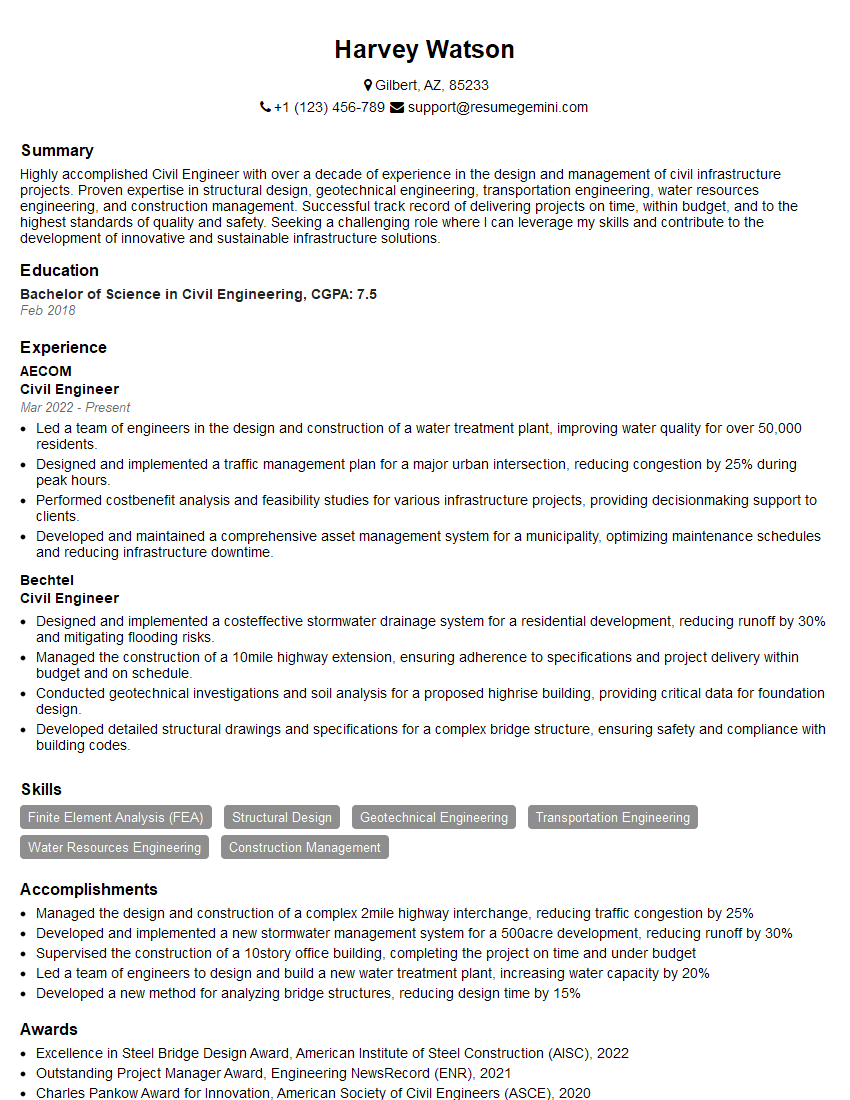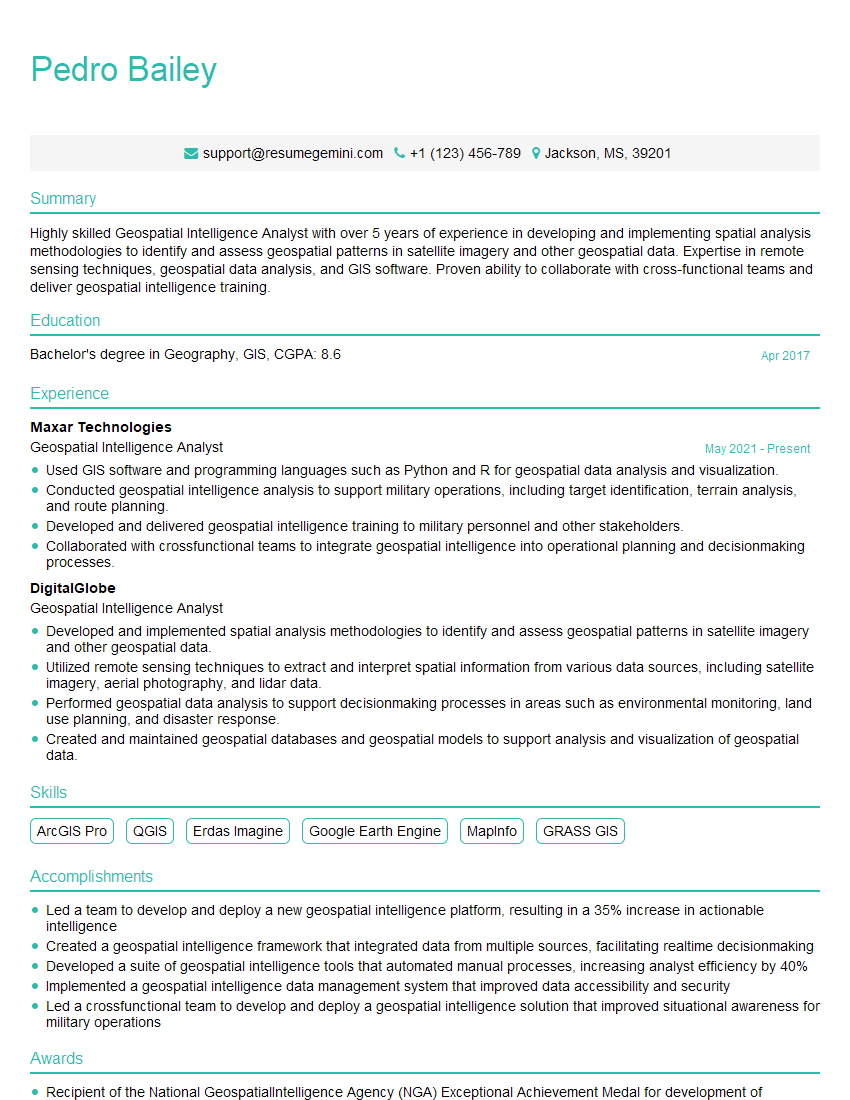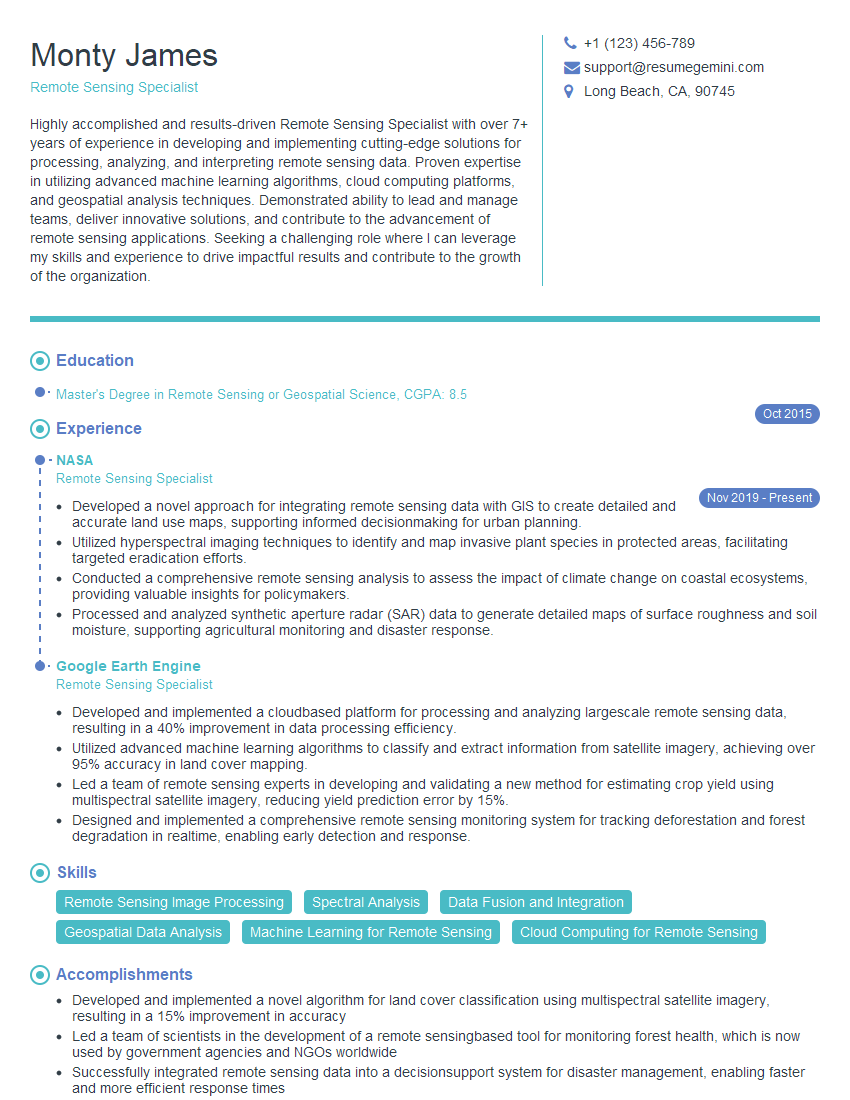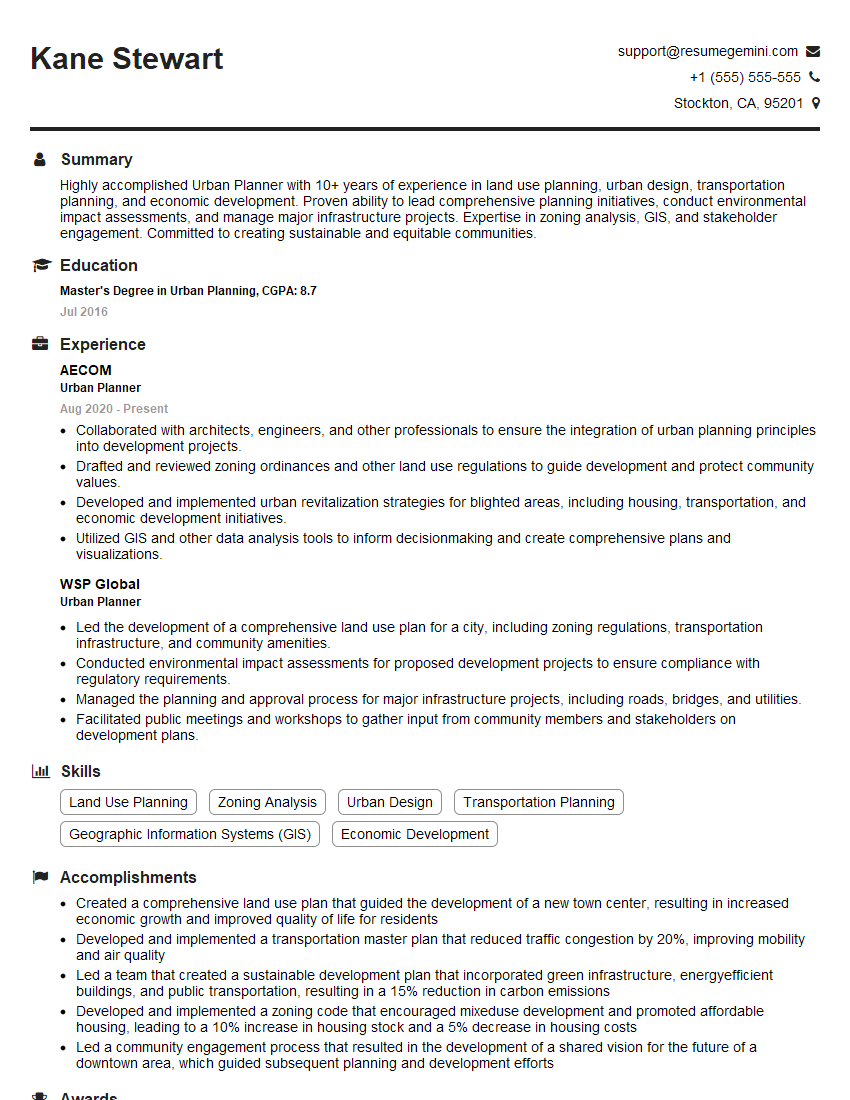Unlock your full potential by mastering the most common Spatial Awareness and Anticipation interview questions. This blog offers a deep dive into the critical topics, ensuring you’re not only prepared to answer but to excel. With these insights, you’ll approach your interview with clarity and confidence.
Questions Asked in Spatial Awareness and Anticipation Interview
Q 1. Describe your understanding of spatial awareness.
Spatial awareness is the ability to understand and interpret one’s surroundings in three-dimensional space. It’s about knowing where you are in relation to other objects, people, and environments. It encompasses both the perception of the immediate environment and the ability to mentally represent and navigate that space. This involves processing visual, auditory, and even kinesthetic information to build a complete picture.
Think of it like this: Imagine walking through a crowded market. Spatial awareness allows you to navigate effortlessly, avoiding collisions, reaching your destination, and understanding the layout of the stalls without bumping into people or things. It’s a crucial skill for everyday life, and even more critical in specialized fields.
- Perception: This involves accurately perceiving the size, shape, distance, and position of objects in the environment.
- Orientation: Understanding your own position and orientation within the space.
- Navigation: Planning and executing movements through the environment efficiently and safely.
- Mental Representation: Creating a mental map of the space to guide future actions and decision-making.
Q 2. How do you use spatial anticipation in your daily work?
Spatial anticipation is crucial in my daily work, which involves (for example purposes) designing efficient warehouse layouts. I constantly use it to predict potential bottlenecks or inefficiencies. For instance, before designing a new layout, I mentally simulate the flow of goods and personnel. I anticipate where congestion might occur based on the size and location of storage areas, the frequency of access to particular items, and the number of employees working in that space. This allows me to design a system where workflows are smooth and optimized. Similarly, if I’m designing a robotics system for a factory floor, I constantly anticipate potential collisions between robots and human workers, and I design safety zones and protocols to prevent such occurrences.
Another example is predicting the need for additional storage space. By anticipating future growth, I can design expandable warehouse layouts, preventing costly disruptions and expansion projects down the line. Essentially, anticipating how space will be used in the future allows me to design optimal, future-proof solutions.
Q 3. Explain how you would assess the spatial relationship between objects in a complex environment.
Assessing spatial relationships in complex environments involves a multi-step process. I would start by using a combination of methods:
- Visual Inspection: A thorough visual survey to identify all objects and their relative positions. This might include using diagrams, 3D models or even virtual reality.
- Measurements and Data Collection: Gathering precise measurements of distances, angles, and dimensions. This could involve using tools like laser scanners, measuring tapes, or surveying equipment. Software like CAD or GIS could greatly help.
- Coordinate Systems: Establishing a coordinate system to define the position of each object precisely. This is often done with respect to a known reference point.
- Spatial Analysis Techniques: Employing spatial analysis techniques such as proximity analysis (measuring distances between objects), overlay analysis (combining different layers of spatial data), or network analysis (analyzing the connectivity of objects in a network) to identify patterns and relationships.
- Software Tools: Utilizing software tools such as GIS (Geographic Information Systems) or CAD (Computer-Aided Design) to model and analyze spatial data visually and quantitatively.
For instance, if assessing the spatial relationship of equipment in a hospital operating room, I’d measure distances between the surgical table, monitors, and sterilization equipment. Then, I could use a software tool to simulate the movement of surgical personnel and identify potential bottlenecks or areas where improvements could be made.
Q 4. Describe a situation where you had to make a quick decision based on spatial awareness.
During a project involving the placement of emergency exits in a large warehouse, I noticed a potential problem during the initial site survey. While the blueprints showed adequate spacing, the actual placement of large machinery obstructed the planned path to one of the exits. My spatial awareness immediately flagged this as a safety hazard. I quickly suggested an alternative exit route based on my understanding of the space and the movement flow of personnel. This proactive approach averted a potentially dangerous situation. It demonstrated the critical role of immediate spatial comprehension and rapid adaptation in practical scenarios.
Q 5. How do you visualize and mentally manipulate spatial information?
I visualize spatial information through a combination of mental imagery and abstract representation. I often create a ‘mental model’ of the space, much like a 3D blueprint in my mind. I can mentally rotate, scale, and manipulate objects within this model to assess spatial relationships and plan movements. For example, when designing a factory layout, I can mentally walk through the space, visualizing the flow of materials and workers. I can then adjust the placement of equipment and machinery to optimize efficiency. This process combines visual and kinesthetic mental representation.
Abstractly, I use tools like coordinate systems and vectors to represent spatial data mathematically, which supports my visual modeling, aiding my planning and prediction.
Q 6. How do you account for potential changes in a spatial environment when planning?
Accounting for potential changes in a spatial environment during planning is crucial. I employ several strategies:
- Scenario Planning: Developing multiple scenarios to account for different possibilities, such as changes in the number of people, equipment, or the addition of new structures.
- Flexibility in Design: Creating flexible designs that can adapt to unforeseen changes. This may include modular designs that can be easily reconfigured.
- Contingency Planning: Developing contingency plans for potential problems or changes, such as unexpected delays or equipment failures.
- Data-Driven Predictions: Utilizing historical data and predictive modeling to anticipate future trends and changes in space usage.
- Regular Monitoring and Evaluation: Regularly monitoring and evaluating the use of space after implementation to identify areas for improvement or adaptation. This might involve tracking foot traffic, equipment utilization, or workflow efficiency.
For instance, when designing a parking lot, I would consider future expansion needs by allowing for extra space or designing a modular layout. I’d also consider potential changes in traffic patterns or the introduction of electric vehicle charging stations.
Q 7. Explain the difference between spatial awareness and spatial reasoning.
While closely related, spatial awareness and spatial reasoning are distinct. Spatial awareness is primarily about the perception and understanding of the current state of one’s surroundings in 3D space. It’s the ‘what is’ of space. Spatial reasoning, on the other hand, is the ability to mentally manipulate and reason about spatial information, to make inferences and solve problems related to space. It’s the ‘what if’ of space. It involves higher-level cognitive processes such as mental rotation, spatial visualization, and problem-solving.
An example illustrates the difference: Spatial awareness allows you to recognize that a particular object is located to your left. Spatial reasoning would involve using that information to plan a path around the object or to predict its movement based on its velocity and direction.
Q 8. How do you use spatial awareness to enhance safety in your work?
Spatial awareness, in my work, is crucial for safety. It’s the understanding of my surroundings and my position within them. This goes beyond simply seeing; it involves actively processing information about distances, orientations, and potential hazards. For example, in a manufacturing setting, spatial awareness ensures I avoid moving machinery or hazardous materials by maintaining a safe distance and understanding their operational range. I constantly assess my environment, predicting potential movement and adjusting my actions accordingly. This proactive approach minimizes the risk of accidents. I also incorporate established safety protocols, ensuring my movements are planned and don’t interfere with the work of others.
- Example: Before entering a warehouse, I mentally map the layout, identifying potential obstacles like pallet jacks or forklifts. I then adjust my walking route to avoid congested areas and maintain a safe distance from active equipment.
- Example: In a field operation involving equipment, I use my spatial awareness to maintain a safe distance from operating machinery and ensure clear communication with colleagues.
Q 9. Describe your approach to solving a spatial problem involving multiple variables.
Solving spatial problems with multiple variables requires a systematic approach. I often begin by visualizing the problem in 3D, utilizing sketching or mental imagery to break down complex interactions. This visual representation helps me to identify key variables and their relationships. I then utilize a step-by-step process:
- Identify Variables: List all relevant spatial elements (objects, distances, orientations, movement).
- Define Relationships: Determine how the variables interact. For instance, how does the movement of one object affect the position of others?
- Constraints: Identify limitations, such as physical boundaries or time constraints.
- Solutions Generation: Brainstorm potential solutions, considering alternative scenarios and the impact of each variable. I might use simulations or modeling software for complex problems.
- Evaluation and Refinement: Assess the feasibility and effectiveness of each solution, making iterative improvements based on the analysis.
For instance, optimizing the layout of a factory floor to improve workflow efficiency involves considering machinery dimensions, worker movement patterns, and material flow. I would use this structured approach to reach an optimal solution.
Q 10. How do you use technology to enhance your spatial awareness?
Technology significantly enhances my spatial awareness. I utilize various tools for data visualization and analysis, ranging from simple mapping software to sophisticated 3D modeling programs.
- GPS and Mapping: GPS systems provide real-time location data, helping me navigate unfamiliar environments and track movements precisely.
- 3D Modeling Software: Programs like AutoCAD or Revit allow me to create and manipulate 3D models of spaces, enabling me to assess spatial relationships and plan actions more effectively.
- LIDAR and other Sensors: LIDAR and other sensors provide detailed point cloud data which can then be used to accurately model and understand complex 3D environments, allowing for enhanced precision and safety.
- Augmented Reality (AR): AR overlays digital information onto the real world, providing real-time data about my surroundings and helping anticipate potential issues before they arise.
By integrating these tools, I gain a more comprehensive and accurate understanding of my spatial environment, improving both safety and efficiency.
Q 11. How do you anticipate potential spatial conflicts or challenges?
Anticipating spatial conflicts requires a combination of experience, systematic analysis, and awareness of potential risks. I employ several strategies:
- Scenario Planning: I consider various scenarios, including unexpected events (e.g., equipment malfunction, changes in workflow). This allows me to develop contingency plans to minimize disruptions.
- Risk Assessment: I identify potential hazards or bottlenecks within the spatial environment. This involves analyzing spatial relationships, predicting movement patterns, and assessing the potential consequences of different actions.
- Historical Data Analysis: Analyzing past incidents or near-misses can highlight patterns and recurring spatial conflicts, helping predict future problems.
- Simulation and Modeling: Using simulation tools allows me to test different strategies and anticipate potential problems before they occur in a real-world setting.
Proactive identification of potential conflicts allows for more effective planning and mitigation strategies, reducing the risk of accidents or inefficiencies.
Q 12. Describe a time you used spatial anticipation to avoid a problem.
During a warehouse operation, a forklift was unexpectedly reversing towards my designated work area. I had developed a strong spatial awareness of the area based on prior observations of the forklift’s typical movements, anticipating this potential conflict. Instead of continuing to my work station as planned, I noticed the forklift’s trajectory and paused. My spatial anticipation allowed me to avoid a potential collision.
Q 13. How do you handle unexpected changes in a spatial environment?
Unexpected changes in a spatial environment require immediate adaptation and a flexible approach. My response involves:
- Rapid Assessment: Quickly evaluate the nature and extent of the change, identifying any immediate hazards or altered spatial relationships.
- Communication: Communicate the change to relevant colleagues to ensure coordinated responses and avoid further conflicts.
- Adaptation of Plans: Adjust plans and actions based on the altered environment, prioritizing safety and efficiency. This may involve re-routing, finding alternative work areas or implementing new procedures.
- Documentation: Document the change and the response to it, learning from the experience and improving future planning.
Adaptability and proactive communication are key to managing unexpected changes safely and effectively. Think of it like navigating a detour: I assess the situation, communicate the change to others, and find a safe and efficient way to reach my destination.
Q 14. How do you translate spatial information into actionable insights?
Translating spatial information into actionable insights involves several steps:
- Data Collection and Analysis: Gather relevant spatial data (maps, sensor readings, measurements). Analyze this data to identify patterns, relationships, and trends.
- Visualization: Create visual representations of the data (maps, charts, 3D models) to enhance understanding and identify potential insights.
- Interpretation: Interpret the data and visualizations to understand the implications of the spatial relationships. For instance, identifying bottlenecks in workflows, areas of high risk, or opportunities for improvement.
- Actionable Recommendations: Based on the interpretation, develop clear and specific recommendations for action. This might involve layout changes, process improvements, or the implementation of safety measures.
- Implementation and Monitoring: Implement the recommendations and monitor their effectiveness, making adjustments as needed.
For example, analyzing the layout of a hospital to optimize patient flow would involve collecting data on patient movement, staff movement, and the location of various departments. This data could be used to visualize bottlenecks and then propose solutions such as redesigning corridors or relocating departments.
Q 15. How do you communicate spatial information effectively to others?
Effective communication of spatial information hinges on choosing the right medium and tailoring the presentation to the audience’s understanding. Think of it like giving directions – you wouldn’t use complex coordinates for someone unfamiliar with maps, but a simple ‘turn left at the bakery’ would suffice.
- Visual aids are paramount: Maps, diagrams, 3D models, and even simple sketches are crucial. For instance, illustrating a proposed building layout with a 3D model allows stakeholders to visualize the space more effectively than just blueprints.
- Clear and concise language: Avoid jargon. Instead of saying ‘proximity analysis,’ say ‘how close things are to each other’.
- Interactive tools: Employ tools that allow for exploration and manipulation of the spatial data. GIS software, for example, enables users to zoom, pan, and query information directly.
- Contextualization: Always provide the relevant context. If you’re presenting data about traffic flow, mention the time of day or specific events that might influence the results. For example, showing traffic congestion at rush hour is different from showing it during off-peak hours.
Ultimately, successful spatial communication ensures everyone shares a common understanding of the location, relationships, and patterns within the data.
Career Expert Tips:
- Ace those interviews! Prepare effectively by reviewing the Top 50 Most Common Interview Questions on ResumeGemini.
- Navigate your job search with confidence! Explore a wide range of Career Tips on ResumeGemini. Learn about common challenges and recommendations to overcome them.
- Craft the perfect resume! Master the Art of Resume Writing with ResumeGemini’s guide. Showcase your unique qualifications and achievements effectively.
- Don’t miss out on holiday savings! Build your dream resume with ResumeGemini’s ATS optimized templates.
Q 16. Describe your process for creating a spatial map or model.
Creating a spatial map or model is an iterative process, starting with a clear objective and culminating in a refined representation. Imagine building a sandcastle; you begin with a general idea, then gradually add detail and refine the structure.
- Define the scope and purpose: What information needs to be represented? What questions will the map answer? For example, a map for emergency responders would differ significantly from one used for urban planning.
- Data acquisition: Gather relevant spatial data. This could involve using GPS data, surveying, remote sensing (satellite imagery), or accessing existing datasets. Imagine collecting sand to build your sandcastle.
- Data processing and cleaning: Clean and prepare the data. This might include correcting errors, projecting data onto a common coordinate system, and handling missing data. This could be like sifting the sand to remove impurities.
- Map creation: Choose the appropriate map type (e.g., thematic map, choropleth map, isopleth map). Select suitable symbology and legends to effectively communicate the information. Selecting the right color scheme and symbol sizes is like adding design elements to make your sandcastle stand out.
- Model validation: Validate the map or model by comparing it to known ground truth or with other data sources. Does your sandcastle accurately represent your vision? Does it have the desired structural integrity?
- Iteration and refinement: Based on feedback and validation, refine the map or model to enhance accuracy and clarity. This is like adjusting your sandcastle’s structure as you go.
Q 17. Explain how you would use spatial data to inform a decision.
Spatial data plays a crucial role in evidence-based decision-making across numerous fields. Consider it like assembling a jigsaw puzzle – each piece of spatial data contributes to the bigger picture, allowing you to make informed decisions.
- Identify the problem and required data: For example, determining the optimal location for a new fire station would require data on population density, response times, road networks, and the location of existing emergency services.
- Data analysis: Analyze the spatial data using appropriate techniques (e.g., spatial autocorrelation, proximity analysis, overlay analysis) to identify patterns, trends, and relationships. You might map the population density, overlay it with the road network and existing stations, and find areas with long response times.
- Spatial modeling: Develop spatial models to simulate different scenarios and predict outcomes. In the fire station example, you might simulate response times under different station locations.
- Decision-making: Use the results of the analysis and modeling to make an informed decision, considering both quantitative and qualitative factors. You could rank potential locations based on simulated response times and other factors.
- Monitoring and evaluation: Monitor the impact of the decision and evaluate its effectiveness using spatial data. For example, after building the new station, you can track response times to see if they improved as predicted.
Q 18. How do you assess the accuracy and reliability of spatial data?
Assessing the accuracy and reliability of spatial data is critical for drawing valid conclusions. Think of it as verifying the ingredients before you start baking a cake; using faulty ingredients will result in a bad cake.
- Source evaluation: Evaluate the credibility of the data source. Is it a reputable organization with established quality control procedures? For example, government-produced topographic maps are generally considered highly accurate.
- Metadata examination: Examine the metadata associated with the data to understand its characteristics, limitations, and potential sources of error. Metadata provides information about the data’s acquisition, processing, and accuracy.
- Data validation: Compare the data against known ground truth or other reliable data sources. This might involve comparing GPS coordinates to surveyed positions.
- Error analysis: Identify and quantify potential sources of error (e.g., measurement errors, positional inaccuracies, data inconsistencies). This could involve assessing the precision of the GPS equipment used to collect the data.
- Uncertainty assessment: Incorporate uncertainty into analyses to account for potential errors in the data. This is important for making informed and cautious decisions.
Q 19. How do you balance speed and accuracy in spatial decision-making?
Balancing speed and accuracy in spatial decision-making is a constant challenge, often requiring compromise. It’s like choosing between a quick sketch and a detailed painting – the sketch might lack detail but offers immediate results; the painting is more accurate but demands significant time.
- Prioritize critical information: Identify the most essential data needed to make a timely decision, focusing on high-impact variables. In an emergency, immediate location data trumps detailed topographic analysis.
- Use appropriate analytical methods: Simple, rapid methods are suitable for time-sensitive situations, while more complex analyses are used where accuracy is paramount. A quick visual inspection of a map might be sufficient for a quick preliminary assessment, whereas a detailed statistical analysis might be needed for a critical planning decision.
- Iterative approach: Start with a rapid assessment and iteratively improve the accuracy of the decision-making process as more information becomes available. Make an initial assessment based on limited data, then refine the assessment as more accurate data becomes available.
- Accept some uncertainty: Time constraints often necessitate accepting a degree of uncertainty. A fast, slightly less accurate response may be better than a perfect response delivered too late. This is a critical factor in emergency response scenarios.
Q 20. How do you handle conflicting spatial information?
Conflicting spatial information requires careful evaluation and reconciliation. Think of it as detective work – you need to sift through different accounts to find the truth.
- Data source evaluation: Assess the reliability and credibility of each source, considering factors such as data age, accuracy, and potential biases.
- Data reconciliation: Attempt to reconcile discrepancies by identifying potential errors or inconsistencies in the data. This could involve checking for errors in data entry, transformation, or inconsistencies in measurement units.
- Spatial analysis techniques: Employ spatial analysis techniques (e.g., spatial overlay, error propagation) to identify and resolve conflicts. For example, overlaying different datasets can highlight areas of disagreement.
- Expert judgment: Involve domain experts to interpret the conflicting information and reach a consensus. Their knowledge can help determine which data source is more reliable and interpret conflicting information.
- Weighted averaging: Consider using weighted averaging techniques to combine multiple data sources, assigning weights based on their perceived accuracy and reliability. This helps incorporate the data while acknowledging the uncertainties.
Q 21. How do you adapt your spatial awareness to different contexts or environments?
Adapting spatial awareness to different contexts requires flexibility and a deep understanding of how spatial information is structured and interpreted in those environments. It’s like learning to navigate different terrains – you’d approach a mountain differently than a city street.
- Contextual understanding: Acquire a deep understanding of the specific environment’s physical characteristics, cultural norms, and potential hazards. For example, navigating a dense urban environment differs greatly from navigating a wilderness area.
- Information gathering: Adapt data acquisition and analysis methods to the context. For example, using satellite imagery in remote areas or detailed street maps in urban settings.
- Mental modeling: Construct and update mental models of the environment based on observed cues and gathered information. This is like building a mental map as you explore a new location.
- Technological adaptation: Adapt the use of technology to aid spatial awareness. For example, using a GPS device in unfamiliar territory or employing specialized software for specific tasks. Using a compass and map in a wilderness setting contrasts sharply with using a GPS in a city.
- Cognitive strategies: Utilize cognitive strategies like wayfinding, landmark recognition, and route planning to improve spatial navigation and decision-making. These strategies are essential in unfamiliar environments or when facing limited visibility.
Q 22. What are some common pitfalls to avoid when relying on spatial awareness?
Relying solely on spatial awareness can lead to several pitfalls. It’s crucial to remember that it’s not a flawless system; it’s susceptible to biases, limitations, and contextual factors.
- Cognitive Overload: Processing too much spatial information simultaneously can overwhelm our cognitive capacity, leading to errors in judgment and missed details. Imagine a busy intersection – trying to process all vehicles, pedestrians, and traffic signals at once can be overwhelming.
- Confirmation Bias: We tend to notice information confirming our pre-existing beliefs, ignoring contradictory data. For example, a driver expecting a car to turn might miss a pedestrian stepping into the crosswalk.
- Inattentional Blindness: Focusing intently on one aspect of the environment can cause us to miss other salient information. The classic ‘gorilla’ experiment perfectly illustrates this—individuals focused on counting basketball passes often fail to notice a gorilla walking across the screen.
- Environmental Factors: Poor visibility (fog, darkness), noise, distractions, and physical limitations (fatigue, injury) significantly impair spatial awareness. A cluttered workspace can hinder effective spatial reasoning.
- Lack of Integration with Other Senses: Spatial awareness shouldn’t be isolated; it’s most effective when integrated with auditory, tactile, and other sensory inputs. Ignoring sounds or ignoring unusual smells might lead to missing potential hazards.
To mitigate these pitfalls, it’s vital to use multiple sources of information, remain vigilant, regularly recalibrate your perception, and be aware of your own limitations. Employing technology like sensors or maps can enhance spatial awareness significantly.
Q 23. Describe your proficiency in using GIS or other spatial analysis software.
I’m highly proficient in using various GIS software, including ArcGIS Pro, QGIS, and Google Earth Engine. My experience encompasses data acquisition, processing, analysis, and visualization. I’m comfortable working with various data formats like shapefiles, raster data, and geodatabases. My expertise extends to spatial analysis techniques such as:
- Spatial Interpolation: Estimating values at unsampled locations using techniques like Kriging or IDW.
- Overlay Analysis: Combining different spatial layers to identify relationships and patterns (e.g., identifying areas suitable for development by overlaying land use, soil type, and slope data).
- Network Analysis: Analyzing connectivity and flow within networks (e.g., optimizing delivery routes or emergency response times).
- Geostatistics: Utilizing spatial autocorrelation and other statistical methods to model spatial phenomena.
For example, in a recent project, I used ArcGIS Pro to model the spread of a wildfire based on wind patterns and fuel type data, generating predictive maps used for resource allocation and evacuation planning. I am also experienced in scripting in Python within the ArcGIS environment to automate repetitive tasks and perform more complex spatial analyses.
Q 24. How do you incorporate human factors into your spatial planning?
Incorporating human factors into spatial planning is paramount for creating functional and user-friendly environments. Ignoring human needs results in designs that are inefficient, inaccessible, or even unsafe. I approach this by:
- Understanding User Behavior: Analyzing how people interact with and navigate a space. This might involve observing pedestrian flows, conducting surveys, or using simulation tools.
- Accessibility Considerations: Designing spaces that are accessible to individuals with diverse abilities, including those with visual, auditory, or mobility impairments. This includes complying with ADA guidelines and considering universal design principles.
- Cognitive Ergonomics: Designing spaces that minimize cognitive load and enhance wayfinding. Clear signage, intuitive layouts, and landmarks are crucial elements.
- Social Interactions: Considering how spatial design influences social interactions and community cohesion. For instance, creating public spaces that encourage social gatherings and interaction.
- Cultural Sensitivity: Understanding and respecting the cultural values and preferences of the community being served. This may influence the design of public spaces or the layout of buildings.
For instance, when designing a park, I would consider the age range of anticipated users, their preferred activities, and accessibility requirements, leading to the inclusion of features like age-appropriate play areas, accessible pathways, and seating areas catering to various needs.
Q 25. Describe your understanding of spatial statistics.
Spatial statistics involves analyzing geographically referenced data to identify patterns, relationships, and trends. It goes beyond simple descriptive statistics by accounting for the spatial dependence inherent in geographic data—nearby locations tend to be more similar than distant ones. Key concepts include:
- Spatial Autocorrelation: Measuring the degree to which nearby locations are similar. Positive autocorrelation indicates clustering, while negative autocorrelation suggests dispersion.
- Geostatistics: Techniques for analyzing spatially continuous data (e.g., elevation, temperature), often involving interpolation and kriging.
- Point Pattern Analysis: Analyzing the spatial distribution of point data (e.g., crime incidents, tree locations) to identify clusters or randomness.
- Spatial Regression: Modeling the relationship between a dependent variable and independent variables, accounting for spatial autocorrelation.
Understanding spatial statistics is essential for accurately interpreting geographic data and making informed decisions. For example, analyzing the spatial distribution of disease cases can help identify potential sources of infection or predict future outbreaks.
Q 26. How do you use spatial data to predict future trends?
Predicting future trends using spatial data involves combining spatial analysis techniques with predictive modeling. This often involves:
- Time Series Analysis: Analyzing changes in spatial data over time to identify trends and patterns.
- Spatial Regression Models: Modeling the relationship between spatial variables and time-dependent factors to predict future values.
- Agent-Based Modeling: Simulating the behavior of individual agents (e.g., people, vehicles) to predict future spatial patterns.
- Machine Learning Techniques: Employing algorithms like Random Forests or Support Vector Machines to predict future trends based on historical data.
For example, I might use historical population density data, land-use changes, and economic indicators to predict future urban growth patterns. These predictions can then inform urban planning decisions, such as infrastructure development or resource allocation.
Q 27. How would you improve spatial awareness training for a team?
Improving spatial awareness training requires a multifaceted approach focusing on both theoretical knowledge and practical application:
- Interactive Simulations: Use virtual reality (VR) or augmented reality (AR) simulations to immerse trainees in realistic scenarios requiring spatial reasoning. This could involve navigating complex environments or responding to emergencies.
- Hands-on Activities: Include activities that require participants to physically interact with their environment, such as map reading exercises, obstacle courses, or real-world navigation tasks.
- Gamification: Incorporate game-like elements into training to enhance engagement and motivation. This could involve competitions, scoring systems, and feedback mechanisms.
- Cognitive Training Exercises: Include exercises designed to improve specific aspects of spatial cognition, such as mental rotation, spatial memory, and visual attention.
- Feedback and Assessment: Provide regular feedback on performance and use objective assessments to measure improvements in spatial awareness.
For instance, a training program for firefighters could incorporate VR simulations of building fires, requiring trainees to navigate smoky environments and locate victims. Regular feedback and debriefing sessions after these simulations can reinforce learning and improve performance.
Q 28. Explain the impact of technology on future needs for spatial awareness.
Technology is profoundly impacting the future of spatial awareness in several ways:
- Enhanced Data Acquisition: Sensors (LiDAR, GPS, drones) provide high-resolution spatial data, improving accuracy and detail in mapping and modeling.
- Advanced Analytics: Machine learning and AI algorithms enable more sophisticated spatial analysis, leading to better predictions and insights.
- Immersive Technologies: VR and AR offer immersive training and visualization tools, enhancing spatial understanding and skill development.
- Real-time Data Integration: Real-time data streams from various sources (traffic sensors, weather stations) enable dynamic spatial awareness and decision-making.
- Automation: Autonomous vehicles and robots rely heavily on advanced spatial awareness capabilities, requiring robust sensor systems and intelligent algorithms.
As a result, future needs will shift towards expertise in data science, machine learning, and the integration of diverse data sources. The ability to interpret and leverage complex spatial data will be crucial for various professions, from urban planning to autonomous systems engineering.
Key Topics to Learn for Spatial Awareness and Anticipation Interview
- Understanding Spatial Relationships: Learn to visualize and interpret spatial data, including distances, directions, and relative positions. Consider how this applies to different contexts, from map reading to complex 3D environments.
- Predicting Movement and Change: Practice anticipating how objects or systems might move or change based on observed patterns and trends. Explore scenarios where this is crucial, such as robotics, autonomous driving, or air traffic control.
- Mental Rotation and Visualization: Develop your ability to mentally rotate and manipulate objects in 3D space. Practice exercises to improve your spatial reasoning and visualization skills.
- Spatial Reasoning and Problem Solving: Focus on applying your spatial awareness to solve problems efficiently. Consider how you would approach optimizing routes, designing layouts, or planning logistics.
- Data Interpretation and Representation: Practice interpreting spatial data presented in various formats (maps, charts, graphs) and converting this information into actionable insights.
- Cognitive Mapping and Navigation: Understand the principles of cognitive mapping and how it impacts navigation and decision-making in complex environments. Explore techniques for efficient route planning and obstacle avoidance.
- Technological Applications: Research how spatial awareness and anticipation are utilized in various technologies, such as GPS systems, virtual reality, or augmented reality applications.
Next Steps
Mastering spatial awareness and anticipation is crucial for success in many high-demand fields, opening doors to exciting and challenging career opportunities. A strong resume is your first step to landing your dream job. Crafting an ATS-friendly resume is essential to getting your application noticed. To make your resume stand out and highlight your skills effectively, leverage the power of ResumeGemini. ResumeGemini offers a user-friendly platform for building professional resumes, and we provide examples of resumes tailored to showcase expertise in Spatial Awareness and Anticipation. Take the next step in your career journey – build a compelling resume with ResumeGemini today!
Explore more articles
Users Rating of Our Blogs
Share Your Experience
We value your feedback! Please rate our content and share your thoughts (optional).
What Readers Say About Our Blog
Hello,
We found issues with your domain’s email setup that may be sending your messages to spam or blocking them completely. InboxShield Mini shows you how to fix it in minutes — no tech skills required.
Scan your domain now for details: https://inboxshield-mini.com/
— Adam @ InboxShield Mini
Reply STOP to unsubscribe
Hi, are you owner of interviewgemini.com? What if I told you I could help you find extra time in your schedule, reconnect with leads you didn’t even realize you missed, and bring in more “I want to work with you” conversations, without increasing your ad spend or hiring a full-time employee?
All with a flexible, budget-friendly service that could easily pay for itself. Sounds good?
Would it be nice to jump on a quick 10-minute call so I can show you exactly how we make this work?
Best,
Hapei
Marketing Director
Hey, I know you’re the owner of interviewgemini.com. I’ll be quick.
Fundraising for your business is tough and time-consuming. We make it easier by guaranteeing two private investor meetings each month, for six months. No demos, no pitch events – just direct introductions to active investors matched to your startup.
If youR17;re raising, this could help you build real momentum. Want me to send more info?
Hi, I represent an SEO company that specialises in getting you AI citations and higher rankings on Google. I’d like to offer you a 100% free SEO audit for your website. Would you be interested?
Hi, I represent an SEO company that specialises in getting you AI citations and higher rankings on Google. I’d like to offer you a 100% free SEO audit for your website. Would you be interested?
good
